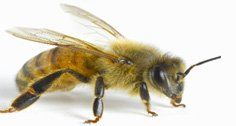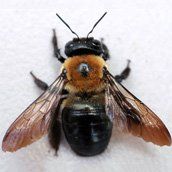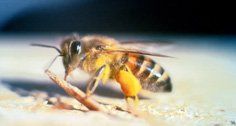Serving:
Middlesex County and the MetroWest Area of MA
-
AN IMPORTANT MESSAGE FROM BEE BUSTERS INC
To our valued customers:
Contact us directly for triage. Call or text for questions or concerns. Remember that a high percentage of our work is done from outside your home!
All our work is guaranteed until 12/31 of the year we treat. New and existing customers call or text today (978) 302-0985.
Be well and stay safe!
Bee Relocation and Removal
Free Phone Estimates | Senior and Military Discounts | Same-Day Service
Free Estimates
Senior and Military Discounts
Same-Day Service
Hours:
After Hours/Emergency Number: 978-302-0985
Appropriate Handling for All Types of Bees
At Bee Busters Inc, we specialize in bee removal! Our team is fully licensed, and we have over 30 years of experience in handling bees of all types.
Some bees are helpful in our ecosystem and agricultural practices, so it's important to properly identify and relocate them to an environment in which they can thrive. You may not want them in your yard, but there are farms where they're welcome!
We make every attempt to safely relocate honey bees.
For your FREE bee identification and FREE bee removal or relocation estimate, please contact Bee Busters Inc today.
European Honeybees
- Honeybees are ⅜” to ¾” long, & sting if provoked. An average hive can consist of 30,000 to 60,000 bees. A bee has 5 eyes, 6 legs, & 4 wings each. She is small, hairy, yellowish-brown in color, & can sometimes be dark brown or black as well. The bulk of the hive consists of infertile female workers; they forage for nectar & pollen, protect the hive against enemies, & produce wax and honey. Worker bees live for 7-8 weeks. A colony includes the queen (a fertile female), workers (infertile females), & drones (males). There is only 1 egg-laying queen in a hive; her life span is 2-8 years. She can produce 1,000-3,000 eggs in one day. Queen larvae are reared in special peanut-like cells & fed more pharyngeal gland secretions than the worker larvae: these secretions are called “royal jelly.” The precise mechanism for this caste differentiation is still unclear. She flies to mate to attract a drone using pheromones.
- The Honeybee flies about 15 miles per hour. The bee will visit 50-150 flowers during one collection trip. Bees carry nectar in their “pollen baskets” on their metathoracic legs. Bees use the senses of taste, touch, smell, & sight. Bees feel sound & can see via ultraviolet colorations. A bee can see movement at 1/300th of a second, or 6 times faster than a human. In the wild, Honeybees can occupy a hollow tree, wall void, soffit, or other protected cavities. When managed, they are reared in supers, within a hive box.
- The drone’s sole purpose in life is to mate with the queen: once they do this, they die. Drones develop by the parthenogenesis from unfertilized eggs that the queen produces by withholding sperm from the eggs laid in large drone cells. They are unneeded members of the hive in late fall, are pushed out of the hive & are often found dead at the base of the hive, frozen. New drones are produced in the spring for mating. They tend to buzz ferociously but lack a stinger & are harmless. Honeybees do not hibernate in the winter. They last out the cold winter by feeding on stored supplies & sharing their body heat, clustering together in a dense pack inside the hive.
- Honeybees use a dance language to communicate to their hive the location of nectar & flowering plant sources. Bees have a built-in clock that appears to be synchronized with nectar in flowers. The honeycomb has 6 sides. Bees make honey from nectar. Pollen is a source of protein. The color of new wax is almost white. Older wax gets dark brown with years of use. Honey production is great in one year and can hold a bathtub’s worth of honey, hundreds of pounds. Honeycomb cells contain either nectar (honey), pollen, or brood (egg, larvae, or pupae) & (nursery cells). A flying worker bee will carry 80% of her body weight in nectar & pollen in one trip. Through a combination of fanning their wings & spreading water drops in the beehive, an air-conditioning effect is created to keep the hive cool during the hot summer months.
- A Honeybee stings once & then dies. The stinger, which has a barb at the end of it, gets lodged in the victim & pulls apart her abdomen after she flies away. If stung, remove the stinger by scraping not by pulling; venom continue to pump until the stinger is removed. The sting is made of melittin, which gives it the “ouch” & “sting.”
- They were brought to North America by European colonists & are thus considered an “invasive species” when compared to native bee species (Bumble Bees) & other pollinators.
- Without the source of honeybees, pollination of many plants, flowers, & fruits would not occur.
- Bees have been affected by disease & parasites, including mites; this has decreased their population.
- It is important to avoid killing a beehive in a wall, first for the pollination issues. Secondly, if killed there is no air-conditioning effect. Thus, the wax melts & the honey leaks out. The best thing that could happen is a new hive sets itself up there; the worst things that could happen, however, include infestation of other pests (ants, roaches, squirrels), & structural damage to the home.
- Swarms are created when a hive gets too large for the area they occupy. A new queen is produced & stays with the old hive. The old queen takes half of the workers & leaves a cluster on a nearby bush or tree while scout bees search for a new home (cavity). At the old nest site, the new queen will search the hive & sting other hatching new queens & begin to rule the hive. Within days, she will mate & expand her hive. A “swarm” is very docile. Workers collect food for 2 days in preparation to finding their new home. A swarm has approx. 30,000 bees.
Carpenter Bees
- Resemble Bumble Bees, but the abdomen is black and shiny.
- Are bees vs. Wasps/Hornets (once colonies are established, they are there permanently (several generations in
- same tunnels every year (like Honeybees, Bumble Bees) vs. new nests and new generations each year
- (Wasps/Hornets)))
- Drill holes that are ⅜ inch in diameter into wood.
- Common drilling areas are decks, eaves, and sidings of houses and other buildings.
- Can be a nuisance to homeowners. Can cause structural damage to affected areas they live in.
- Can more often affect unfinished wood, older painted wood that is stained or waterproofed, & can drill in furniture.
- Will not leave you alone when provoked; queen will match your every move.
- Bees like to hover in one place for long periods of time. - resembling hummingbird activity.
- Approximately 730 species of Carpenter Bees.
- Have the ability to travel long distances and visit many different flower types.
- Are mainly active at dawn and dusk during the summer.
- Female bees will stand guard at the nest entry hole (queens are very territorial).
- Bees will defend their nest aggressively (will fight to the death to protect tunnels).
- One queen per tunnel complex entrance and will mark entrances with pollen and “bee poop” (combination of yellowish staining and shavings at each tunnel entrance).
- Once the queen has drilled her nest, she will forage during the day to supply food for her young.
- Male bees hang around flowers to hope to find a receptor female. They “buzz” loudly to attract her. People feel that they are being “attacked” when they hear this “buzz.”
- Males do not have stingers. Females have stingers.
- Old nests are used year after year (multiple generations per tunnel complex). Problems will escalate quickly if not treated and handled promptly and properly.
- Carpenter Bee larvae are large and noisy. They make enough noise to attract woodpeckers (if woodpeckers are
- banging on wooden sidings of houses or buildings, the customer knows that they have either a Carpenter Bee or
- Carpenter Ant infestation in the wood itself).
- The female will tunnel into the wood just a short distance (approximately ½ to 1 inch) and then turn and tunnel
- along the grain of the wood. In this tunnel, which could extend 6 to 18 inches long, she will place a mixture of
- pollen and nectar upon which she lays an egg. She then seals off that portion of the tunnel and then repeats this
- process until the tunnel is full. The eggs hatch into larvae and will develop through the summer. The larvae mature
- into adults and emerge in the late summer.
- A Carpenter Bee infestation is often first detected by finding large amounts of sawdust on the ground below the
- area being drilled.
- Activities of numerous bees can cause considerable structural damage to homes or buildings.
- After the holes of the bee have been treated by a professional, sealing is recommended once all eggs hatch out to prevent wood-rot, water damage, or attraction of other pests. Do not seal up the hole until all eggs hatch and are properly treated. Sealed holes can be drilled out easily by a young bee.
Bumble Bees
- Family: Apidae, or Social Bees.
- Survive annually: die out each Autumn, leaving only young, mated queens to survive the winter and start new colonies next Spring.
- Large queens found in early Spring are busy feeding and searching for nesting sites after their long hibernation.
- Bees are ⅜ to ⅞ inches long, robust, and hairy. Each bee can sting multiple times.
- Often found nesting in compost piles, walls, underground in varying locations, mossy coverings, old animal holes, and many other locations. Nests consist of “honey pots” (comb and brood-cells made from waxy materials). Honey pots store the pollen and nectar, as well as being a depository site for eggs.
- The queen sits on her eggs like a brooding hen sipping honey from her pots waiting for her offspring to hatch. When workers emerge, her receptor is used for nectar.
- Populations vary from year to year depending on environmental factors.
- The larger workers maintain the covering over the nest and collect food, and smaller ones care for the young larvae and do the inside work.
- Unlike wasps, they are very docile and non-aggressive, and go about their business with little attention to human activities, even when you are close to their nests.
- If a colony is unearthed or disturbed, it should be left alone and simply covered over again. The bees will quickly repair any damage and carry on as before.
- Superior to other bees in pollination of red clover, since they have a tongue that is 2.5 millimeters (0.1 inches) longer than that of honeybees.
- Often considered haphazard in their ways. Colonies are not well organized like other flying stinging insects. They are pollinators and it is suggested to leave them alone unless they decide to build in a place where they are disturbed, like under a set of steps or in an area of high traffic.
- They like to construct their nests in the ground, within insulation or close to the ground.
- Often confused with Carpenter Bees. Inspect the body to verify, - Bumbles have fluffy rear quarters. Their environment & living situation is much different than the Carpenter Bee.
Africanized Honeybees
- Look like other Honeybees.
- Are more aggressive.
- Swarm more often.
- Attack in large numbers.
- Nest closer to the ground than European Honeybees.
- Are in warmer temperatures of the country and are moving further north each year.
- Will pursue an intruder for the length of a football field, while a European Honeybee will only pursue an intruder for about 1/10 of that distance.
- The common Honeybee of this region is called the “Italian Honeybee.” The Africanized Honeybee, the so-called “killer bees,” were imported from Africa to South America in the 1950s.
- They are a more aggressive bee. They sting with little provocation, more like a Yellow Jacket.
- These bees are widespread in South America, & now their habitats are encroaching into Mexico & Texas. A swarm was transported into California in 1985.
- Their effect on beekeeping in the USA is uncertain.
- It is also uncertain how far north they will be able to travel & survive.
Call for a Free Over-the-Phone Estimate
Same-day service is available, and we're on call 24/7 for emergencies.
(978) 263-2663
We'll identify your pest for free!
Text us a picture at (978) 302-0985!
We Honor Your Service
Senior and Military Discounts - $25 Off
Be sure to let us know if you qualify for our senior or military discount when you call! Cannot be combined with any other offer. Contact Bee Busters Inc for details. Call Today (978) 263-2663
Call
HOURS
Mon - Fri 9:00 am - 5:00 pm
Sat Emergency Service Only
Sun Emergency Service Only






Share On: